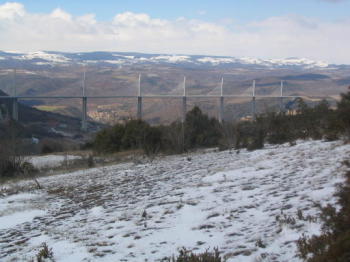We are developing the social individualist meta-context for the future. From the very serious to the extremely frivolous... lets see what is on the mind of the Samizdata people.
Samizdata, derived from Samizdat /n. - a system of clandestine publication of banned literature in the USSR [Russ.,= self-publishing house]
|
With the price of crude oil holding over $50 per barrel, how long will it be before the more flexible parts of the Green movement start arguing that nuclear power is actually not such a bad idea after all?
I ask this question because it seems to me that Britain, like a lot of other western nations, could be facing a Californian-style energy shortage fairly soon. It goes without saying that such an issue is completely off the political radar right now.
Comment away!
Our standing orders on Samizdata are to write not just about certain specific areas of thought and policy, but about what is on our minds. I take this as an invitation to stray beyond the obvious and beyond our core expertises, such as they are. Not everything here is even supposed to make complete sense.
In that spirit, let me tell you about two pieces of writing which, taken together, struck me as interesting. They are pretty interesting even separately, but together they get even more interesting. Anyway, see what you think.
The first piece of writing is a book called The Cradle of Thought, by Peter Hobson, who is an expert on autism, but not only on autism. Hobson’s subject matter is not just the particular form of unusual thought and experience called autism, but also the light that this and other abnormalities throw on the processes of normal human thought. (One of the best ways to understand how something is supposed to work is to examine what happens when something or someone damages it or in some way interrupts its smooth working.)
What comes across from this book is that thinking, of the sort that most of us do most of the time, is an intensely social thing. It starts not just with me thinking about that. It starts with me thinking about that by learning what you already think about that. What you (typically my mother) think(s) is the thing that gets me started with my thinking.
So, if I am the sort of me who is especially disposed not to pay attention to what you (my mum) are (is) thinking, that changes how I think, about everything. I may become very expert, by default, about things, but remain permanently baffled by people, and in particular by the notion that other people have a point of view of their own which I can tune into, and by the idea that other people are accordingly very different from other mere things.
This book seems to be quite well known and quite highly regarded, so there is no shortage of further verbiage to read about it should you feel the urge, now that you have heard a little of my point of view about it.
The other piece of writing was this article and related discussion, about dogs, and about the differences between dogs and such animals as wolves and foxes, which I got to via the ever interesting and stimulating Arts & Letters Daily. → Continue reading: Autism, dogs, etc.
How do scientists work? Do they spend a lot of their time holed up in big buildings with lots of fancy equipment, work in large teams or mostly alone, with rumpled air and just a blackboard and lump of chalk trying to figure out the laws of physics? What sort of social lives do they lead and how do they handle the political, business and personal demands that come their way? How do they deal with hostility from jealous colleagues, skeptical review boards and college principals worried about expanding their budgets?
If you ever wanted to know some of the answers to these questions as well as have a rattling good yarn told, then this book, an old classic by Gregory Benford, fits the bill. I have been engrossed in it for the last few days and I won’t spoil for any would-be readers by giving the ending or basic plot away. Let’s just say that this book actually gave me the feeling of actually working and living in a science lab, of hanging around scientists in the early 60s and later, in a sort of crumbling, environmentally troubled 1990s. Strongly recommended.
Interesting story here that a firm which is said to be behind a lot of the spam messages hitting our mailboxes could go bust. Perhaps, just perhaps a corner might be turned in the current battle against spammers. I used to think that one man’s junk mail message was another’s piece of legitimate advertising, but the relentless offensive and downright moronic crud I have to sweep from my computer each day has made me change my mind. The effectiveness of the Internet as a business and social tool has been seriously blunted by this phenomenon.
I still don’t really know whether spam can be best dealt with legally, economically or through some other means. What I do know is that I won’t be shedding any tears at the demise of one of the most prolific producers of this stuff in the world.
Dale Amon is too busy to blog about this himself, but emails the rest of us with news about this, from Novosti:
Russia still leads the way in space exploration. Russia’s Clipper reusable spacecraft will be unveiled during the 2005 MAKS aerospace show in Zhukovsky near Moscow. This spacecraft, which is developed by the Energia corporation, will seat six people. The Clipper, which can fly to the moon, can also be used for reaching the Red Planet. This was disclosed to Izvestia by Anatoly Perminov, general director of Russia’s Federal Space Agency.
Quite where the Energia corporation now sits in the public-private spectrum, I do not know. I suspect that both state money (bad) and the desire for commercial gain (good) are involved here, a lot. But most of all, I suspect that the plain old-fashioned desire to (best of all) fearlessly and braving all dangers get out there and to courageously explore new frontiers and to ruthlessly (and whatever is the Russia equivalent) split infinitives, etc., is what is really going on.
Good for them. The Russians have not had much to cheer about lately. This kind of thing may be expensive, and “irrelevant”, no answer to poverty, blah blah, but it will surely make at least some of them a bit happier.
It makes me think of that moment in 10 Things I Hate About You, one of the recent-ish Hollywood products that I did like a lot despite these Hollywood moans, when, after a surprisingly successful date with the object of his affections, that young guy who was also in Third Rock from the Sun, thinks about it all, and then grins hugely and smacks his steering wheel with both hands and shouts: “And I’m back in the game!”
John Quiggin of Crooked Timber has posted about a fascinating legal case. Two Chinese players of an online game acquired a valuable virtual sword. What happened next?
One of them borrowed it and sold it for about $1000. The other player went to the police without result, and eventually confronted his partner, and in the ensuing argument, pulled a knife and stabbed him to death. It’s sad that this happened, but the most interesting aspect for those not directly involved is the question of whether the seller had committed a crime, and if so what.
Perhaps some Samizdata readers who are lawyers or gamers or both can help him out. (Although F. Gregory Lastowka and Dan Hunter already have written a paper.)
Even more interesting than the legal question is the evolution of the game worlds in ways, good and bad, that the designers don’t anticipate or want. A commenter to John Quiggin’s post, Keith M Ellis, says:
But it strikes me that the game designers have some oddly familiar problems on their hands: they want a particular outcome, but people self-organize in ways that make it very hard to simply engineer that particular outcome.
The libertarian angle on that is obvious. Is the Hobbesian outcome that some (apparently rather a high proportion) of the players seem to go all out to make others have a bad playing experience a challenge to our worldview?
Yet another aspect is the interaction between the game world and the real world. Another commenter, “asg” says:
In World of Warcraft, there are two factions (the Horde and the Alliance). Players from the two factions aren’t allowed to communicate across faction lines—they can’t talk to each other, mail each other, group with each other, etc. Some enterprising players discovered that, while the game garbled their speech for players on the opposite side, it didn’t garble digits or punctuation, so someone developed a code to allow cross-faction communication. The latest patch put an end to that.
For some reason I thought of this from the point of view of the fictional game characters, not the players. The thought of the characters in the game world, forbidden to speak to their enemies, yet finding a way to communicate by going outside the bounds of their own reality, would make a story worthy of Philip K Dick.
The Guardian newspaper reports that two-thirds of the world’s resources have been “used up”, so with only a third left, the crunch cannot be far away for Planet Earth. (Let’s hope Hollywood is on the case). The splendid Cafe Hayek blog nicely chews up and spits out this Malthusian argument here.
I have a question. If the resources of the Earth are finite and everything eventually succumbs to the Second Law of Thermodynamics, then by the logic employed by the deepest of Greens, even if we recycle all our goods and live in mud huts, then at some point, the game is up, we are all doomed, the end is nigh. So my question would be that if this is so, then why not live life to the full and enjoy this “finite” world while we have it? Let’s get those SUVs, build those spacecraft, take those lavish holidays, create those new technologies. It is all going to end anyway, so enjoy!
Of course, the idea that resources are finite has been challenged by the late and much-missed Julian L. Simon. The Ultimate Resource is his masterwork. And what is the ultimate resource? You probably have guessed – the grey stuff between your ears.
I nearly choked on my tea when I read in my news alerts that the United Nations’ International Telecommunications Union wants to be given more influence over the Internet. I persevered and learnt ‘interesting’ things (interesting as in the Chinese curse “may you live in interesting times“…) The Chinese connection is somewhat relevant – Houlin Zhao, the venerable bureaucrat who heads the ITU, is a former government official in China’s Ministry of Posts and Telecommunications.
So, we have a UN agency, run by a (former) Chinese government official saying that they should be able to run more aspects of the Internet. Zhao wrote in December:
Countering spam is just one of many elements of protecting the Internet that include availability during emergencies and supporting public safety and law enforcement officials… The ITU would take care of other work, such as work on Internet exchange points, Internet interconnection charging regimes, and methods to provide authenticated directories that meet national privacy regimes.
In an interview with CNET news, Zhao explains ITU’s position:
ITU’s situation is similar to the U.S. Constitution. ITU is very dynamic. We try to keep abreast of the latest development of the market and to give assistance to human society for future development. Remember, ITU was created in May 1865 to develop a system for telegraphs.
The US Constitution…well, isn’t that nice? But then I read this and shudder:
One of the most important changes was the early stages, when the Internet started, when ICANN started in 1998. The purpose was to exclude governments (but that didn’t work). People realize today that the governments worldwide have to play a role.
No, Mr Zhao, people do not realise that the governments have a role to play, especially given that internet has been the fastest developing, innovative and dynamic technological and social advance that humankind has even known. Brining governments into it is just going to put a big spanner into the works. If anything, people have learned that you can have an entire dimension of your existence i.e. online functioning just fine, if not better, than the offline.
People say the Internet flourished because of the absence of government control. I do not agree with this view. I argue that in any country, if the government opposed Internet service, how do you get Internet service? If there are any Internet governance structure changes in the future, I think government rules will be more important and more respected.
What we have here is an example of authoritarian meta-context, Mr Zhao assumes that there are only two options – government opposition to internet service or complete control. Otherwise his statement does not make sense. How about no interference either way?

At the moment, my fellow Samizdatista Michael Jennings is somewhere in South China. In fact, a few minutes ago, he crossed the border from the “Special Administrative Zone” in Hong Kong, and into the Shenzhen region(?) of China.
How do I know this? Well, he just sent me an SMS message saying so. Quite extraordinary that it is easy as pie to send a message from China to Australia in such a manner. Of course, it is amazing how blase one gets to modern technology. I have grown in the habit of sending him SMS messages to his phone when he’s in Europe, without thinking about it. Usually we send sports scores and commentaries to each other; as cricket coverage is thin on the ground in China, I’m keeping Michael up to date with the latest scores from the cricket Test in Wellington.
A curious thought- there’s a new “Star Wars” movie coming out soon, and I watched the trailer online last night. In the “Star Wars” universe, SMS has of course been rendered obsolete by holograms. It is all rather futuristic, but is it practical?
No doubt it is technically possible. One of the very bright engineers in the Samizdata.net readership might like to explain what it would require. But will it ever catch on? I am not so sure.
One technology that is here and now is video telephones, marketed here in Australia by 3 Mobile. A cousin of mine gave them a whirl, and I asked her how it went. She reported that it wasn’t as good as she thought; too often, she was not comfortable with her appearance or did not want to have her caller identify her exact location. Although she found the technology quite clever, she found it intrusive, and not as useful as she had hoped.
I think if a clever engineer ever developed a hologram means of communication such as we see in the “Star Wars” movies, they might be dismayed by the lack of interest shown in it.
I will tell you why. Like many bloggers, I blog in my pajamas, and I would shudder to think of letting anyone seeing me in such a state. Especially since, with today being Sunday, I’ve not the slightest of intention of dressing up. I can send SMS messages to South China and no one need know how badly dressed I am. This relatively simple method of communication will be with us for quite a while yet.

Much has been written about the recently opened Millau Viaduct in the south of France, both here and elsewhere. It takes the form of statistics: 245m from the foot of the valley to the deck, 343m from the foot of the valley to the top of the towers, 2.5km long in total. A cost of €394m to build.
Going out of my way to see the great bridges of the world is something that I do, and after reading all this I was struck by a strong urge to go and see the bridge for myself. So, I flew to Toulouse this last weekend. I rented a car, and headed for Millau. I was in no hurry. I stopped for a pleasant lunch in Albi, and rather than going up the main road, I then wound along the litte roads following the Tarn valley. One thing became obvious quickly. The Tarn valley is a huge gash through the south of France, going for hundreds of kilometres. There was clearly no easy way to build a motorway across it, anywhere. The immensity of the new viaduct was clearly out of necessity.
I had some thoughts of following the Tarn river valley all the way from Albi to Millau, with the idea that I would appreciate the scale of the valley, finally glimpse the viaduct in the distance when I was a few kilometres from it, (or maybe tens of kilometres, depending on the geography), and then approach it and eventually drive under it.
As it happened though, this was not quite what happened. The drive up the valley was spectacular, but it was a difficult drive, due to a narrow road (with some very lengthy narrow tunnels from an earlier era of engineering), and some awkward driving conditions. (It was very cold. Much of the river valley and even some of the road was covered in snow). And I kept stopping due to the fact that the scenery was beautiful and at times remarkable. (The small village of Ambialet, built in a truly extraordinary curve in the river, kept me for some time, as did a few other places).

This part of France had an odd feeling of abandonment about it though. There are a lot of small villages along the river, containing beautiful old stone buildings, but these contained very few people and. I get the impression that the valley was a (fairly marginal) agricultural location a generation or two back (potatoes I would guess) but that is now gone. There are a few shops in the villages but these were mostly closed. The permanent population of these places appears to be small, and demographically not especially young. The buildings are generally in good repair, however. I get the impression that this place is highly seasonal. Tourists and owners of holiday homes probably come in summer in huge numbers for canoeing, kayaking, hiking, hang-gliding and various other activities, but not in the winter. Which is a shame, because in winter under the snow the valley was beautiful. But to attract people in winter you need to offer skiing, and this is not skiing country.
But on to the bridge. → Continue reading: Very Cool
A few decades ago, the curse of malaria, which for centuries had made large parts of the world uninhabitable and killed millions, had been largely eradicated because of the pesticide DDT. However, as many will know, this chemical was banned after a long campaign by environmentalists, concerned that the substance worked its way through the entire food chain, possibly causing cancers and other ailments. The writer Rachel Carson, in her famous, or perhaps infamous, book Silent Spring, helped focus Greens’ righteous anger on DDT.
The outcome may have been splendid for the mozzies, and possbily may also have had beneficial consequences for various species of flora and fauna. However, its impact on those awkward beings known as humans has been drastic. Millions are now dying at a high rate as malaria stages a virulent comeback.
I like to be a charitable chap and imagine that a lot of environmentalists feel worried about this, but I suspect that a good deal of do-gooders who had argued for the abolition of DDT feel not a nano-second’s qualm about the impact of what has happened.
Malaria is not a subject that may get pop singers like U2’s Bono all excited, as is the case with AIDS, but the death toll is huge, and it is growing.
For the last several weeks I have been watching with growing pleasure, every Monday night from 8 pm to 9 pm, two episodes at a time, one of those Channel 5 TV series that tend to pass without much comment or many claims of significance, called Massive Engines.
Last night saw the airing of the final two episodes, number 9 about massive pumps, and number 10 and finally, about the massive jet engines that enable modern airliners to ply their trade. The presenter was Chris Barrie, who is probably best know for comedy-of-embarrassment characterisations like Rimmer in Red Dwarf, or Brittas in The Brittas Empire, and in Massive Engines there are occasional Rimmer/Brittas style, self-send-up moments of leaden humour. The impression you get is that Barrie is not as sure as he would like to be that he is keeping his audience’s attention.
For myself, I absolutely do not think Barrie need have worried. Whenever, which was most of the time, he forgot about being comical and concentrated on explaining the whys and wherefores of his various massive engines, often while himself operating them and with every sign of knowing pretty much what he was doing, I was held, and fascinated.
I learned all kinds of things I never knew. For instance, in the last show, about aircraft engines, I learned that on an early aircraft engine, not only did the propeller rotate, but the cylinders also, firmly attached to the same bit of the engine as the propeller, and rotating along with the propeller. To keep them cool. Amazing. Well, you probably knew that, but I had no idea. You probably also know that whereas petrol engines work with regular explosions, diesel engines (names after a German bloke called Diesel) do not feature externally induced explosions. The pressure caused by the cylinder coming back up again is enough to set fire to the next lot of fuel. Well, I sort of vaguely did know that. But now I know it a little better.
In general, throughout the run of the show, Barrie’s quick and clear explanations of the principles behind all the mechanisms he was describing were, well, amazingly quick, and amazingly clear.
The only episode which I found a bit weak was the one about motorbikes, which featured rather too much footage of Barrie trundling about rather pointlessly on a motorbike, in between the serious explanatory stuff. The trouble with motorbikes is that frankly, they are not massive. They got as big as they will ever be many decades ago, and anyway, the point of them is speed, plain and simple, rather than speed (or anything else for that matter) achieved through massiveness.
That episode aside, all the engines on show got steadily bigger and more effective throughout their history. They are not necessarily massive any more. The pumps, for instances, that shift water hither and thither used to be a lot bigger, when they were steam engines, than they are now, now that they are diesel or electrical engines or whatever. But a good few of the engines Barrie talked about with such enthusiasm are huge right now, and getting ever huger.
The earth moving kit they now use is unbelievably huge, as was proved with a trip to a massive open cast coal mine in Germany, where there were also earth-shifting lorries with wheels the size of terrace houses. The machines used to dig tunnels are now as massive as they have ever been. As are those aircraft engines of course.
I expected the airplane episode with which the show ended to be a commercial for the Airbus A380, but actually it was a commercial for the Rolls Royce Trent Alphabetsoup engine. No Airbuses were mentioned, but a Boeing was, the two engine 777, which is apparently almost as huge as the four engine 747.
I recall no mention whatsoever of the wickedness of massive engines from the environmental point of view, which was most refreshing. On the contrary, massive engines got massive because they were used, again and again, to solve massive environmental problems, such as the environmental mess that the London sewage system had become towards the end of the nineteenth century, or the massive problem of travelling vast distances across the damn environment, most especially the sea. (There was an episode devoted to massive ships.) The entire show was a continuous hymn of praise to the God of the Technical Fix. You have a problem? Building a massive engine to solve it.
I cannot claim to remember all the technical details that were laid out before me on Massive Engines, but when they were being laid out I recall very, very clearly that they did make perfect sense, at the time. Had I written the stuff down, I am confident that only my own handwriting would have then stopped it making perfect sense now.
What I am really saying is, if I come across DVDs of this show at a suitably miserly price, I would definitely consider buying them, and watching the whole show again, repeating the quick and clear explanations and fast forwarding through the motorbike trundling.
As a potential interester of intelligent and intellectual curious children, boys especially of course, these shows would, I feel sure, prove excellent.
And Chris Barrie’s Rimmerisms might even help from that point of view. By the end, even I was enjoying the rest of it so much that I found myself smiling instead of wincing when Barrie started up yet another massive engine not with a “right let’s start this thing up”, but instead by shouting rather self-consciously: “let’s rock”. Very embarrassing dad. But when you really like the serious work that someone is doing, you can put up with mannerisms and foolishnesses that would drive you insane if it was just another pointless idiot doing them. And when they are gone, you even find you miss them.
So, an outstanding show, and particular proof of the value of having lots of different TV channels, allowing lots of different points of view besides the official one, which as far as massive engines is concerned is now that massive engines are, at best, a necessary evil, and at worst, just plain evil.
|
Who Are We? The Samizdata people are a bunch of sinister and heavily armed globalist illuminati who seek to infect the entire world with the values of personal liberty and several property. Amongst our many crimes is a sense of humour and the intermittent use of British spelling.
We are also a varied group made up of social individualists, classical liberals, whigs, libertarians, extropians, futurists, ‘Porcupines’, Karl Popper fetishists, recovering neo-conservatives, crazed Ayn Rand worshipers, over-caffeinated Virginia Postrel devotees, witty Frédéric Bastiat wannabes, cypherpunks, minarchists, kritarchists and wild-eyed anarcho-capitalists from Britain, North America, Australia and Europe.
|






